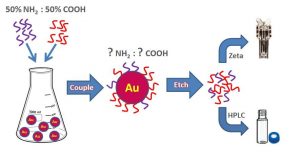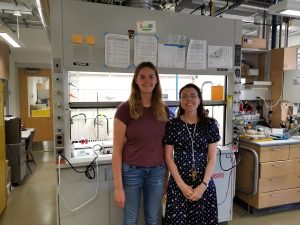This summer, my project was to determine if we can control the ratio of two types of dendrons (amine- and carboxylate-terminated) when preparing mixed-monolayer gold nanoparticles. In the Daniel lab, gold nanoparticles coated with PPI (polypropyleneimine) dendrons are researched as a possible platform for the simultaneous delivery of chemotherapeutic drugs with imaging and targeting moieties. The reaction in which dendrons are coupled to gold nanoparticles requires an excess of dendrons, and it has not yet been established whether the dendrons coat the gold particles in whatever ratio they are present in the initial reaction mixture, or whether their affinities for the gold particles are influenced by their terminal groups.

Although quantification of the total number of dendrons coating the particles is relatively simple, determining the proportions of each type of dendron is complicated by the fact that the large molecules (both with MW ~ 1400 g/mol) differ only in the nature of their end groups. I synthesized gold nanoparticles, coupled them to dendrons in different ratios, dissolved the gold cores with iodine, and after purification ran the recovered dendron through HPLC and Zetasizer. I developed an HPLC method that allowed both dendrons to elute from the column, but due to the low limit of detection of the UV-Vis detector and the small amounts of dendrons coming off the particles I also investigated the use of zeta potential to determine the relative adsorption of the two types of dendron to gold nanoparticles.
